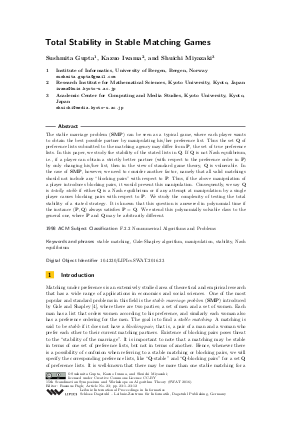Total Stability in Stable Matching Games
Authors Sushmita Gupta, Kazuo Iwama, Shuichi Miyazaki
-
Part of:
Volume:
15th Scandinavian Symposium and Workshops on Algorithm Theory (SWAT 2016)
Part of: Series: Leibniz International Proceedings in Informatics (LIPIcs)
Part of: Conference: Scandinavian Symposium and Workshops on Algorithm Theory (SWAT) - License:
 Creative Commons Attribution 3.0 Unported license
Creative Commons Attribution 3.0 Unported license
- Publication Date: 2016-06-22
File

PDF
LIPIcs.SWAT.2016.23.pdf
- Filesize: 489 kB
- 12 pages
Document Identifiers
Subject Classification
Keywords
- stable matching
- Gale-Shapley algorithm
- manipulation
- stability
- Nash equilibrium
Metrics
- Access Statistics
-
Total Accesses (updated on a weekly basis)
0Document
0Metadata
Abstract
The stable marriage problem (SMP) can be seen as a typical game, where each player wants to obtain the best possible partner by manipulating his/her preference list. Thus the set Q of preference lists submitted to the matching agency may differ from P, the set of true preference lists. In this paper, we study the stability of the stated lists in Q. If Q is not Nash equilibrium, i.e., if a player can obtain a strictly better partner (with respect to the preference order in P) by only changing his/her list, then in the view of standard game theory, Q is vulnerable. In the case of SMP, however, we need to consider another factor, namely that all valid matchings should not include any "blocking pairs" with respect to P. Thus, if the above manipulation of a player introduces blocking pairs, it would prevent this manipulation. Consequently, we say Q is totally stable if either Q is a Nash equilibrium or if any attempt at manipulation by a single player causes blocking pairs with respect to P. We study the complexity of testing the total stability of a stated strategy. It is known that this question is answered in polynomial time if the instance (P,Q) always satisfies P=Q. We extend this polynomially solvable class to the general one, where P and Q may be arbitrarily different.
Cite As Get BibTex
Sushmita Gupta, Kazuo Iwama, and Shuichi Miyazaki. Total Stability in Stable Matching Games. In 15th Scandinavian Symposium and Workshops on Algorithm Theory (SWAT 2016). Leibniz International Proceedings in Informatics (LIPIcs), Volume 53, pp. 23:1-23:12, Schloss Dagstuhl – Leibniz-Zentrum für Informatik (2016)
https://doi.org/10.4230/LIPIcs.SWAT.2016.23
BibTex
@InProceedings{gupta_et_al:LIPIcs.SWAT.2016.23,
author = {Gupta, Sushmita and Iwama, Kazuo and Miyazaki, Shuichi},
title = {{Total Stability in Stable Matching Games}},
booktitle = {15th Scandinavian Symposium and Workshops on Algorithm Theory (SWAT 2016)},
pages = {23:1--23:12},
series = {Leibniz International Proceedings in Informatics (LIPIcs)},
ISBN = {978-3-95977-011-8},
ISSN = {1868-8969},
year = {2016},
volume = {53},
editor = {Pagh, Rasmus},
publisher = {Schloss Dagstuhl -- Leibniz-Zentrum f{\"u}r Informatik},
address = {Dagstuhl, Germany},
URL = {https://drops.dagstuhl.de/entities/document/10.4230/LIPIcs.SWAT.2016.23},
URN = {urn:nbn:de:0030-drops-60450},
doi = {10.4230/LIPIcs.SWAT.2016.23},
annote = {Keywords: stable matching, Gale-Shapley algorithm, manipulation, stability, Nash equilibrium}
}
Author Details
References
-
G. Demange, D. Gale, and M. Sotomayor. A further remark on the stable matching problem. Discrete Applied Mathematics, 16:217-222, 1987.

-
L. E. Dubins and D. A. Freedman. Machiavelli and the Gale-Shapley algorithm. The American Mathematical Monthly, 88(7):485-494, 1981.

-
L. Ehlers. Truncation strategies in matching markets. Mathematics of Operations Research, 33(2):327-335, 2008.

-
D. Gale and L. S. Shapley. College admissions and the stability of marriage. American Mathematical Monthly, 69:9-15, 1962.

-
D. Gale and M. Sotomayor. Ms. Machiavelli and the Gale-Shapley algorithm. American Mathematical Monthly, 92(4):261-268, 1985.

-
D. Gusfield and R. W. Irving. The Stable Marriage Problem-Structure and Algorithm. The MIT Press, 1989.

-
N. Immorlica and M. Mahidian. Marriage, honesty and stability. In Proceedings of SODA'05, pages 53-62, 2005.

-
H. Kobayashi and T. Matsui. Cheating strategies for the Gale-Shapley algorithm with complete preference lists. Algorithmica, 58:151-169, 2010.

-
M. S. Piny, F. Rossi, K. B. Veneble, and T. Walsh. Manipulation complexity and gender neutrality in in stable marriage procedures. Auton. Agent Multi-Agent Systems, 22(183-199), 2011.

-
A. E. Roth. Misrepresentation and stability in the marriage problem. Journal of Economic Theory, 34:383-387, 1984.

-
A. E. Roth and U. G. Rothblum. Truncation strategies in matching markets-in search of advice for participants. Econometrica, 67(1):21-43, 1999.

-
A. E. Roth and M. Sotomayor. Two-Sided Matching: A Study in Game Theoretic Modeling and Analysis. Cambridge Univ. Press, 1990.

-
C-P. Teo, J. Sethuraman, and W-P. Tan. Gale-Shapley stable marriage problem revisited: Strategic issues and applications. Management Science, 47(9):1252-1267, 2001.

